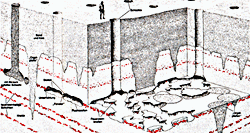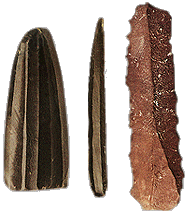
|
|
Blades (lames) were long narrow stone tools and were at least twice as long as broad. To produce blades, rocks of good quality like flint and obsidian were required. Upon these hard rocks, using the technique Levallois, prismatic cores were formed and subsequently, the flakes with parallel edges, the so-called blades, were removed from these cores. Their cutting sides were particularly sharp and therefore appropriate for cutting vegetables or animal food. Blades were procuced for the first time in the Middle Palaeolithic
|
 Towards the end of the Palaeolithic and during the Mesolithic periods, blades were used for the production of microliths. The use of obsidian and flint blades was common in the Neolithic Period and in the Bronze Age as well. Quarries of obsidian and flint have been traced in Europe and they testify to the systematic exploitation of these rocks from the Neolithic Period. Obsidian quarries have been found at Nychia on Melos and flint quarries at Rijckholt in Belgium. |
 |
 |
 |
 |
 |
 |
